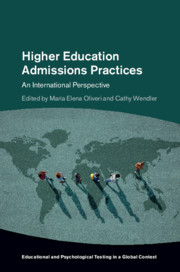Book contents
- Higher Education Admissions Practices
- Educational and Psychological Testing in a Global Context
- Higher Education Admissions Practices
- Copyright page
- Contents
- Figures
- Tables
- Contributors
- Series Editor’s Foreword
- Foreword
- Acknowledgments
- Part I Global Challenges and Common Admissions Models
- Part II Country-Specific Admissions Practices
- Part III Assessments Used in Higher Education Admissions
- Part IV Rethinking Higher Education Admissions
- Index
- References
Part I - Global Challenges and Common Admissions Models
Published online by Cambridge University Press: 09 January 2020
- Higher Education Admissions Practices
- Educational and Psychological Testing in a Global Context
- Higher Education Admissions Practices
- Copyright page
- Contents
- Figures
- Tables
- Contributors
- Series Editor’s Foreword
- Foreword
- Acknowledgments
- Part I Global Challenges and Common Admissions Models
- Part II Country-Specific Admissions Practices
- Part III Assessments Used in Higher Education Admissions
- Part IV Rethinking Higher Education Admissions
- Index
- References
Summary
The chapters in Part I provide an overview and critical discussion of college-level higher education admission practices from around the world. This discussion illustrates common goals, concerns, and challenges related to: broadening higher education admissions criteria to diverse populations; improving student preparation to meet labor market demands; and preparing students to complete increasingly more advanced courses, all from an international perspective.
Keywords
Information
- Type
- Chapter
- Information
- Higher Education Admissions PracticesAn International Perspective, pp. 1 - 118Publisher: Cambridge University PressPrint publication year: 2020
References
References
References
References
References
References
References
Accessibility standard: Unknown
Why this information is here
This section outlines the accessibility features of this content - including support for screen readers, full keyboard navigation and high-contrast display options. This may not be relevant for you.Accessibility Information
- 1
- Cited by
